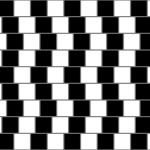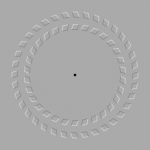5 Things to know about perception
Each day we perceive our environment by seeing, hearing, smelling and feeling. We take our perceived reality for granted and don’t challenge it. Nevertheless it is very important to know the limits of our perception and to make a distinction between what we perceive and what reality is really like.
In the following article I will introduce 5 facts about our perception and thereby give examples of why our brain is the one that shapes our reality.
-
Perception is influenced by subconsciousness

(c) cc-by | Dominic Alves
Everything you perceive is dependent on some basic expectations your brain has. You won’t recognize things until your brain has learned to give them meaning. An interesting example for this statements are chicken sexers that have to determine the sex of chicks. Quite a difficult task if you keep in mind that they all look same. It is an own profession whereby most chicken sexers come from Japan. They can distinguish between male and female chicks in matter of seconds whereas we as outsiders wouldn’t believe that this is possible. It is like learning how to drive a car. At first you will have a lot of problems but after a while automation starts. You just do stuff without problems, but when you are asked to describe how you do it, your conscious mind will give a dusty answer (you are just not aware of all details you are paying attention to).
Same with the example of the chicken sexers. Many wanted to learn this trick so they traveled to Japan. The surprise was that the professional chicken sexers couldn’t describe how they do it. The only way to learn the method was to watch them doing it. For perception that means that it is different for everyone. You can perceive more than others by improving your visual perception for specific situations.
-
You don’t need eyes to see

(c) cc-by | Clyde Robinson
Our brain is a very magical instrument when it comes to learning new things. It can even learn new ways of perceiving things. The following Scientific American article titled Tasting the Light: Device Lets the Blind “See” with Their Tongues gives an astounding example for that. Neuroscientists from Middleton took three devices: a webcam (integrated into sunglasses), a lollipop and a little computing device. By connecting them altogether with wires they created their product called “Brainport”.
The webcam films your current environment. The digital images are then processed by the extra device to pixelated black and white images. These images are then passed to the lollipop that has a grid with 400 electrodes on it. The currency of each electrode is depending on whether there is a black or white pixel in the current pixelated image respectively on the shade of the pixel.
Brainport is not able to compete with the real thing: around two million nerves are needed to transmit the visual information from your retina to your brain. Nevertheless the tongue has a lot of nerves in it and enabled first steps of perceiving the environment after around 15 minutes.
I think there is no need to explain what meaning it had for blind people to recognize their first objects or letters by help of this new kind of perception. One remaining question though is where exactly this information is processed in the brain: it can either be processed in the visual cortex or in the somatosensory cortex (touch and taste area of the brain).
Read dailymail for a precise setup and further information.
-
Perception is relative
You probably know that feeling when time passes very quickly if you are doing things you enjoy and that time passes very slowly if you are doing things you dislike. In an experiment of the University of St. Thomas in Minnesota the counter relation was tested.
In the experiment people had to do a specific task and were told a wrong time that they needed for fulfilling the task. Afterwards they were asked if they enjoyed the task. They enjoyed the task if they were told that they only needed 5 minutes (instead of 10 minutes) and disliked the task if they were told that they needed 20 minutes instead.
This example not only shows that you are unaware of what you actually perceive, but moreover it shows a dependency between happiness in life and time perception. The topic time perception is difficult to access, because many people will give contradictory statements if you ask them to define how they perceive time.
By using today’s state of the art brain scanning techniques (fMRI) a high activity in the insular cortex was found when people’s brains were scanned while they were asked how they perceived time for a specific task. Emotion and consciousness are believed to be managed in this part of the brain. Therefore it makes sense that if you are emotional and by that unaware of your body for example when you are watching an exciting film, time seems to fly by whereas if you are aware of your body time seems to pass slowly.
Read this BBC article for more about this experiment and time perception in general.
-
Perception is fictional
Everyone believing in the things you see is making a big mistake. One of the simplest example for that are optical illusions.
This optical illusion is called Café wall illusion. Although all bars are parallel they seem to be sloped. Only because the squares are slightly shifted we perceive a wrong idea of what the picture actually is like. Our brain is applying its expectations of how the lines have to flow on what we see. This results in a wrong perception.
Stare at the point in the middle and move your head back and forwards repeatedly. You will notice that the rings around the center start to rotate. Once more our visual perception is manipulated by our brain.
One interesting fact at this point is that only little of what our eyes perceive is passed to the visual cortex. Thereby your brain creates a bigger amount of what you see from memory and expectation.
See optical illusion for more.
-
You never perceive the full reality

(c) cc-by | Whit Andrews
I recently heard the following example: we are like water skimmers on the water surface. We can look in all directions but down. Yet under water there is a whole different world that we are not able to perceive. We perceive 3 dimensions and time. This example underlines that our perception is very limited. There could be multiple dimensions or even multiple universes out there that behave like radio-waves. They are frequently there but we can’t perceive them. In physics for example the string theory permits multiverses, so it could be not just science fiction. At this point I suggest you to watch the brilliant physics videos of Michio Kaku on the youtube channel bigthink.
If you are interested in the topic perception I recommend the book: Incognito: The Secret Lives of the Brain by the neuroscientist David Eagleman. It is not very profound but therefore easy to read and it gives a nice overview about functionality of perception and our mind. This article gives insight into some contents of his book.






Mohib
January 12, 2015 at 14:21It's very informative.....(y)